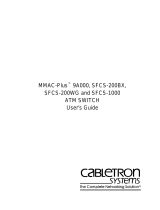
4
Juniper’s core solutions deliver unparalleled investment protection
with Physical Interfaces Cards (PICs) that are portable between
Juniper Networks M Series Multiservice Edge Routers including the
M40e, M120, M320 and the T320, T640, T1600 and multichassis
systems. These PICs cover diverse interface types (ranging in
speed from DS3 to 100-Gigabit Ethernet) including SONET/SDH,
ATM, Gigabit Ethernet, dense wavelength division multiplexing
(DWDM), and advanced security services. From dense Gigabit
Ethernet and 10-Gigabit Ethernet configurations (including two
10x10 Gigabit Ethernet PICs in a single T1600 slot), to high-speed
trunk applications at 40 Gbps and beyond, T Series routers satisfy
every core application up to the 6.4-terabit realm. The OC-768c
and 100-Gigabit Ethernet options are ideally suited for intra-POP
(point of presence) locations. The 4-port OC-192, with inverse
multiplexing, provides 40 Gbps inter-POP links up to a distance of
80 Km.
Using Junos OS and the JCS1200, service providers can enjoy
operational simplicity and feature superiority while alleviating
the need for complex and costly mapping of software releases
to hardware versions. The top 30 service providers worldwide all
utilize the power of Junos OS, and its unique agility and ability
to scale services across all interfaces helps speed the rollout of
new service deployments while simplifying management and
operations. JCS1200 is a scalable, independent control plane
that uses the power of Junos OS to create the industry’s first true
network convergence: consolidated POPs, virtualized network
functions and services, and high-performance route reflectors.
One of the key architectural choices in the T Series family of
routers is the non-disruptive hardware upgrade. This is seen in the
simple migration from T640 to T1600 (Figure 3) and from T1600
to the large, virtualized systems consisting of the TX Matrix Plus
and the JCS1200.
Figure 3: The In-service hardware upgrade of T640 to T1600
is the only one of its kind
3. Swap the face panel
2. Swap switch interface
boards
• 5 SIBs per chassis, can run on 4
• Disable a SIB, swap it, re-enable
• Repeat 4 times
1. Swap power entry modules
• 2 PEM per chassis, system can run
on one
• Disable, power off the first PEM
on one
Features and Benefits
The T Series routers is a proven architecture, with over 5000 units deployed in the world’s largest networks.
Table 2: T Series Features and Benefits
FEATURE DESCRIPTION BENEFIT
Multi-terabit capacity and
multichassis scalability
T1600 scales to 1.6 Tbps in a single chassis. The TX
Matrix Plus allows incremental expansion up to a 6.4
Tbps system. The future-proof architecture scales
comfortably to well beyond this capacity as provider
needs progress.
Total Internet trac continues to grow at over 80
percent per year. T Series scale and density features
allow service providers to increase capacity without
adding additional systems to the network.
High availability hardware There is no single point of failure in T Series routers.
Component-level redundancy is available for routing
engines, control boards, and SIB, as well as PEMs and
the internal control plane.
High availability (HA) and continuous operation is
critical in core routing, where loss of a single routing
node can remove service for a wide geographical area.
High availability soware Non stop active routing provides the foundation for
ISSU, as well as Junoscript commit script capabilities,
mean continuous operation under maintenance
conditions, and topological changes.
HA requirements in core networks include the
elimination of planned downtime. Key benefits include
higher operational network availability, better network
stability, easier operations, and less operational risk.
Superior packet processing via
programmable ASIC-based Packet
Forwarding Engine (PFE)
Juniper’s programmable ASICs deliver a
comprehensive, hardware-based system for packet
processing. To ensure a non-blocking forwarding
path, all channels between the ASICs are oversized,
dedicated paths. Firewall filter capabilities are scalable
to hundreds of thousands of entries, and include
multiple matches and conditions.
Highly granular QoS, advanced filter-based forwarding,
flow-based monitoring, and distributed denial of
service (DDoS) prevention. All competing core routing
implementations allow for a mere fraction of the
total firewall filter terms supported on Juniper routers
without performance degradation.
Wide range of interfaces Interfaces on the T Series range from DS3 to OC-768
(SONET) and 100-Gigabit Ethernet for Ethernet.
Juniper provides the largest variety of interfaces
among core routing platforms. This interface variety
(both optical and copper) is unique in the market.
Combining the functions of previously disparate
network elements oers greater network simplicity,
and retains the service-building advantages of the
overlay networks being replaced by the converged
network.









